Introduction
The world of sales is constantly evolving, and in this dynamic landscape, the ability to accurately identify and understand potential customers is more crucial than ever. This is where the concept of lead qualification, a cornerstone of effective sales strategies, comes into play. Essentially, lead qualification acts as a filter, enabling sales teams to sift through a pool of prospects to pinpoint those most likely to make a purchase. It’s about differentiating ‘hot’ leads, ready for conversion, from ‘cold’ ones, who may require more nurturing or may not convert at all.
This blog delves into the nuances of the BANT framework, a renowned method for lead qualification. BANT, an acronym for Budget, Authority, Need, and Timeline, is a structured approach that assesses leads based on these critical dimensions. We’ll explore how each element—understanding a potential customer’s budget, identifying the decision-makers, recognizing their specific needs, and determining the timeline for purchase—plays a pivotal role in qualifying leads.
Furthermore, we’ll illustrate how integrating this framework with automated workflows, leveraging tools from platforms like Nanonets Workflows, can significantly enhance its efficiency. Whether you’re new to BANT or seeking to refine your sales techniques, this guide provides actionable insights to implement the BANT framework effectively, empowered by automation.
Why is lead qualification important?
So, why is lead qualification important? Imagine going on a treasure hunt without a map, digging randomly in hopes of finding something valuable. It’s a hit-or-miss approach that’s inefficient and exhausting. Lead qualification is like having that treasure map. It guides your sales efforts, helping you to focus on the probable areas where you’re most likely to find the ‘treasure’—in this case, the potential customers who are a perfect fit for what you’re offering. This process ensures that your time and resources are strategically invested in engaging with prospects who are not only interested but are also best positioned to make a purchase.
BANT Framework for Lead Qualification
Now, let’s explore a popular method of lead qualification called BANT. The acronym BANT stands for Budget, Authority, Need, and Timeline. Here’s what each of these terms means in simple terms:
- Budget: How much is the potential customer willing or able to spend? This helps to understand if they can afford your product or service.
- Authority: Does the person you’re talking to have the power to make the buying decision? Knowing this ensures you’re dealing with the right person.
- Need: What is the customer’s requirement that your product or service can fulfill? This helps to determine if what you offer is a good fit for them.
- Timeline: When does the customer plan to make the purchase? This information helps in understanding their urgency or readiness to buy.
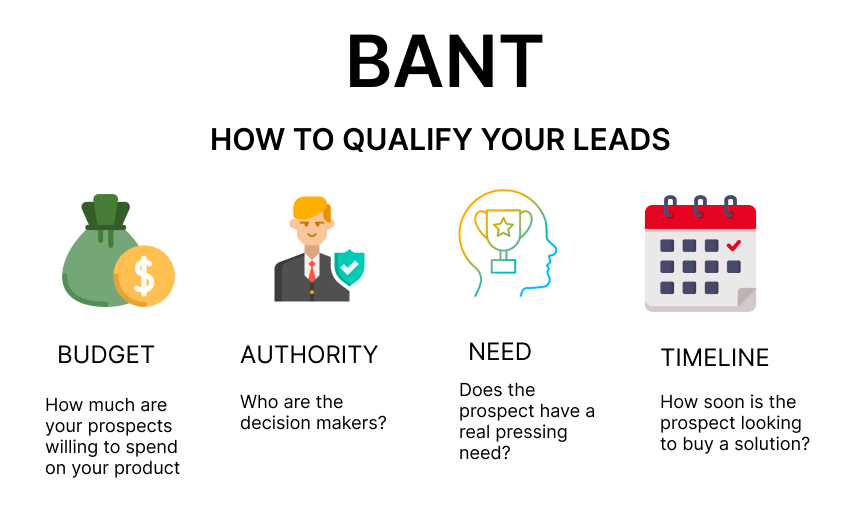
In practice, for each potential customer or ‘lead’, we gather information related to these four aspects. Here is an entity-relationship diagram illustrating a dataset of leads with BANT (Budget, Authority, Need, Timeline) data. Each lead is associated with BANT attributes.
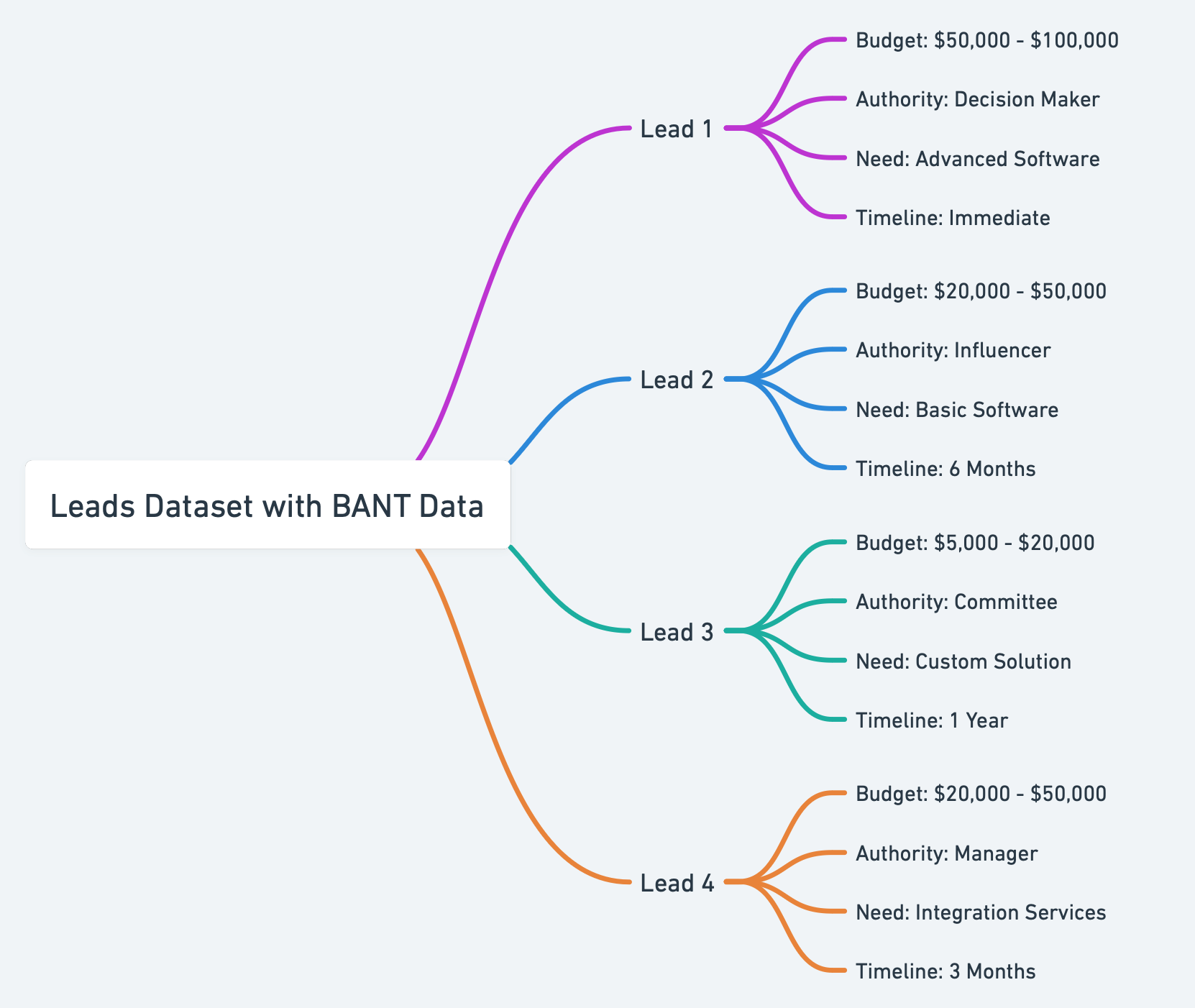
Now, based on past data with historical leads or our domain expertise in the field, we set specific criteria for each BANT element. We then apply these criteria to the information we have on each lead to filter them. The leads that meet these criteria are considered ‘qualified’. In other words, they are the ‘hot’ leads – those most likely to make a purchase and become customers.
How to Create your BANT Framework
Implementing the BANT framework in your sales process is a strategic way to enhance lead qualification and improve efficiency. Here’s a step-by-step guide on how your sales team can get started, even if your team hasn’t used a structured framework before:
1. Understanding BANT and Preparing Your Team
- Educate Your Team: Begin by training your sales team on what BANT stands for – Budget, Authority, Need, and Timeline. Explain the importance of each component in the context of your products or services.
- Budget: Knowing a prospect’s budget helps you understand if they can afford your product or service. This prevents wasting time on leads that won’t convert due to financial constraints. It’s like knowing how much someone is willing to spend before recommending a product – ensuring it’s within their price range.
- Authority: It’s crucial to talk to the person who can say ‘yes’ to the purchase. Imagine trying to get permission for something – you’d want to ask the person in charge, not just anyone. This way, your sales team avoids wasting time with people who can’t make the final decision, making their efforts more efficient.
- Need: Understanding the prospect’s specific needs or problems lets you tailor your pitch to how your product or service can solve those issues. It increases the likelihood of the lead seeing value in your offer. You act like a doctor understanding a patient’s symptoms to prescribe the right medicine.
- Timeline: Knowing when a prospect plans to buy helps in prioritizing leads and optimizing follow-up strategies. It helps in focusing efforts on those who are ready to make a decision soon. It’s akin to knowing when someone is planning to eat before offering them a meal – you wouldn’t offer lunch to someone who isn’t that hungry yet, or someone who just ate.
2. Asking the Right Questions to Fill the BANT Form
Expanding on the types of questions to ask under each BANT category requires a careful approach that combines tact and thoroughness. Here’s an introductory explanation of how to frame and ask these questions, with examples:
- Budget Questions
- Objective: To understand the prospect’s financial capacity and willingness to invest in your solution.
- How to Ask: Start with general, open-ended questions and then gradually get more specific. It’s important to create a comfortable atmosphere so the prospect doesn’t feel pressured.
- Example 1: “Could you give me an idea of the budget you’ve allocated for this type of solution?” This question is non-intrusive and allows the prospect to provide a range or a ballpark figure.
- Example 2: “In previous projects similar to this, what kind of investment did your company make?” This question helps understand their historical spending patterns, giving you insight into their budget expectations.
- Authority Questions
- Objective: To identify the decision-makers and understand the decision-making process.
- How to Ask: These questions should be framed to gather information without making the prospect feel sidelined.
- Example 1: “Who will be the key decision-maker for this project? I’d love to ensure all their concerns are addressed.” This question directly identifies the decision-maker while showing respect for their role.
- Example 2: “Could you walk me through the typical decision-making process for a purchase like this in your organization?” This gives a holistic view of the process and identifies key players.
- Need Questions
- Objective: To understand the prospect’s specific challenges and requirements.
- How to Ask: Focus on open-ended questions that encourage the prospect to share detailed information.
- Example 1: “What are the main challenges you’re hoping to solve with our solution?” This invites the prospect to discuss their pain points openly.
- Example 2: “Among the features we offer, which ones do you find most relevant to your needs?” This helps in gauging their interest and prioritizing the features they care about.
- Timeline Questions
- Objective: To determine the urgency and expected time frame for the purchase and implementation.
- How to Ask: Questions should be straightforward yet flexible enough to accommodate the prospect’s planning and constraints.
- Example 1: “Do you have a specific timeline in mind for implementing this solution?” This gives a clear idea of their urgency or schedule.
- Example 2: “Are there any external factors, like events or fiscal cycles, influencing your timeline for this decision?” This addresses external pressures they might be facing, which can be crucial in understanding their timeline.
- Additional Tips
- Build Rapport First: Before diving into BANT questions, establish a connection with the prospect. This makes them more comfortable sharing information.
- Listen Actively: Pay attention to the prospect’s responses. Their answers can lead to follow-up questions that provide deeper insights.
- Contextualize Questions: Tailor your questions based on the industry, the size of the company, or the role of the person you’re speaking to. This shows that you have done your homework and are genuinely interested in their specific situation.
- Be Adaptive: If a prospect is hesitant to answer a question directly, be flexible and try a different approach or gently revisit the question later in the conversation.
- Role-Playing and Scenarios: Use role-playing exercises to simulate sales conversations. This helps your team get comfortable with asking the right questions.
3. Designing the BANT Form
Designing an effective BANT form involves selecting the right type of data fields for each BANT variable to capture the necessary information accurately and efficiently. Let’s take a look at the possible options for each BANT variable.
- Budget
- Range Selection: Provide pre-defined ranges like ‘<$10,000’, ‘$10,000-$50,000’, ‘>$50,000’, etc. This helps in quickly categorizing leads by budget size.
- Authority
- Multiple-Choice Questions: These are ideal for identifying the role of the contact. Options can include ‘Decision Maker’, ‘Influencer’, ‘End User’, ‘Consultant’, etc.
- Hierarchical Select: If the decision-making process involves multiple layers, a hierarchical select can help identify where the contact sits in the decision hierarchy.
- Executive Leadership (e.g., CEO, CFO, CTO)
- Department Head (e.g., Head of IT, Head of Marketing)
- Team Leader/Manager
- Individual Contributor
- Need
- Checkboxes: Allow leads to select from a list of common challenges or needs that your product/service addresses, and get a coverage percentage.
- Likert Scale: To gauge the intensity or priority of each need (e.g., ‘Not Important’, ‘Somewhat Important’, ‘Very Important’).
- Timeline
- Radio Buttons: For a clearer, single-choice selection of a time frame. Use pre-defined time range options like ‘Within 1 month’, ‘1-3 months’, ‘3-6 months’, ‘6 months or more’. This helps in understanding the urgency.

4. Implementing BANT in Your Sales Process
- Integrate BANT in CRM: Add BANT fields in your Customer Relationship Management (CRM) system to track and evaluate leads efficiently.
- Regular Review and Update: Ensure that your team regularly updates the BANT information in the CRM as they progress through conversations with leads.
5. Evaluate Lead Quality
One can now go for either binary lead qualification or lead scoring to get ‘hot’ leads.
Binary Lead Qualification
Binary lead qualification is a straightforward, ‘yes’ or ‘no’ approach. It involves setting specific criteria for each BANT variable, and a lead must meet all these criteria to be considered qualified.
- Set clear standards for each BANT category. For example, Budget might have a minimum threshold, Authority requires the contact to be a ‘decision-maker’ or ‘helper’, Need aligns closely with your product’s features, and Timeline is within an actionable period like the next three months.
- A lead is qualified if they meet all these standards. If they fall short in even one category, they’re not qualified.
- Suppose you’re selling high-end software solutions. Your binary criteria might be: Budget over $50,000; Authority with a Director level or above; Need for specific advanced features; Timeline for purchase within the next quarter. A lead meeting all these criteria is marked as ‘qualified’.
Lead Scoring
Lead scoring is more nuanced than binary qualification. It assigns different weights to various BANT elements based on their importance, creating a score that reflects the lead’s overall qualification level.
- Weights should be based on your sales strategy and historical data. If Budget is usually the key deciding factor, assign it higher weight. If the decision-maker’s level (Authority) is crucial, increase its weight.
- Continuing with the software solution sales, let’s assign weights
- Budget: 30 points
- Authority: 25 points
- Need: 25 points
- Timeline: 20 points
- Next, define how points are awarded within each category. For example:
- Budget:
- Over $100,000: 30 points
- $50,000 – $100,000: 15 points
- Below $50,000: 0 points
- Authority:
- C-level executive: 25 points
- Director: 20 points
- Manager: 15 points
- Others: 0 points
- Need:
- Perfect match: 25 points
- Partial match: 15 points
- Low match: 5 points
- Timeline:
- Within 3 months: 20 points
- 4-6 months: 10 points
- More than 6 months: 5 points
- Budget:
- Use the formula to calculate the total lead score by summing up the points awarded in each category: Total Score = Budget Points + Authority Points + Need Points + Timeline Points
- Let’s calculate the score for a hypothetical lead:
- Budget: $100,000 (earns 30 points)
- Authority: Manager (earns 15 points)
- Need: Perfect match (earns 25 points)
- Timeline: Within the next 6 months (earns 10 points)
- Total Score = 30 + 15 + 25 + 10 = 80
Using this scoring system, leads with higher scores are prioritized as they are more likely to convert based on the criteria set by your sales strategy. It’s a quantitative way to assess lead quality, allowing for more objective decision-making in the sales process.
In both approaches, leads are categorized based on how well they fit your ideal customer profile. Binary qualification is more black-and-white, offering a clear-cut decision, while lead scoring provides a graded understanding of how close each lead is to being the ideal customer. These methods help prioritize follow-ups, ensuring the sales team focuses their efforts where they’re most likely to succeed.
6. Feedback Loop
Implementing a feedback loop is essential for refining and optimizing the BANT framework. This involves regularly collecting and analyzing feedback from your sales team about their experiences with the BANT process.
- Regular Meetings: Schedule periodic meetings where the sales team can discuss their experiences with the BANT framework. Encourage open dialogue about what’s working and what isn’t.
- Analyze Sales Data: Look at the performance data to see how well leads that scored highly in the BANT process are converting. This can help identify if certain BANT criteria are more indicative of sales success than others.
- Adjust BANT Criteria: Based on the feedback and data analysis, make necessary adjustments to the BANT criteria and scoring system. This might involve reweighting certain elements or refining the questions asked.
- Continuous Learning: Encourage the sales team to view BANT as an evolving tool. Regular updates and refinements based on actual sales experiences will make it more effective over time.
7. Historical Analysis Exercise (Optional but Recommended)
Conducting a historical analysis exercise can significantly help in understanding the efficacy of your newly created BANT framework.
- Gather Historical Sales Data: The sales team should revisit their initial conversations and meetings with historical leads. The goal is to retroactively fill in the BANT fields based on these early interactions. It’s like piecing together a puzzle using clues from your past sales experiences.
- Apply BANT Retroactively: Once the BANT forms are filled for at least 100-200 historical leads, use the current BANT criteria to score or classify these leads as if they were being evaluated today.
- Compare with Actual Outcomes: Look at the eventual outcome of these leads – whether they converted into customers or not. This comparison will reveal how accurately the BANT framework would have predicted their potential.
- Refine BANT Framework: Refine the framework based on the analysis.
By implementing these steps, your sales team can not only adopt the BANT framework more effectively but also continuously refine it to better align with your customer profiles and market dynamics.
8. Nurture Less Qualified Leads
Even after implementing the BANT framework, you’ll encounter leads that don’t fully meet the set criteria. These less qualified leads can now be nurtured. This involves implementing strategies to keep them engaged and gradually guiding them towards qualification.
- Segmentation: Start by categorizing less qualified leads based on which BANT criteria they fall short in. This helps in tailoring your nurturing strategies more effectively.
- Targeted Content: Create content that addresses the specific gaps each segment has. For example –
- Budget: Create a blog post or infographic that outlines the long-term cost savings and ROI of your product or service. This can help the lead understand the value and justify a higher budget. An article titled “Maximizing ROI: How Investing in [Your Product] Saves Money in the Long Run”.
- Authority: Develop a concise, persuasive presentation or one-pager that the lead can share with their higher-ups. This content should clearly articulate the benefits of your product. A downloadable PDF guide titled “Presenting the Benefits of [Your Product] to Your Management Team”.
- Need: Let’s say the lead is unsure how your product/service meets their specific needs. Share case studies or testimonials from past customers, especially those with similar backgrounds or needs. This demonstrates how your product has successfully addressed similar challenges. A case study video featuring a satisfied customer who had similar needs, discussing how your product helped solve their problem.
- Timeline: Provide content that keeps your product top of mind and educates the lead about the benefits of timely implementation. This could include articles on industry trends showing the urgency of adopting solutions like yours. An e-book or blog series titled “Staying Ahead: Why Now is the Right Time to Implement [Your Product]”.
- Personalized Email Campaigns: Develop email sequences that slowly build up the value of your offering. Include case studies, testimonials, and industry insights relevant to each lead’s segment.
- Regular Follow-up Calls: Schedule periodic calls to check in with these leads, update them on new offerings, and understand any changes in their needs or circumstances.
9. Additional Points for an End-to-End Process Setup
- Training on Soft Skills: Teach your team how to naturally integrate BANT questions into conversations without making the prospect feel interrogated.
- Regular Monitoring and Analysis: Regularly review how well leads that passed the BANT criteria are converting into customers. This analysis can help in fine-tuning your BANT criteria.
- Integrating with Marketing Efforts: Work with your marketing team to create content and campaigns that address common needs and questions related to your BANT criteria.
By following these steps and continuously refining your approach based on feedback and results, your sales team can effectively implement the BANT framework and improve the quality of lead qualification. Remember, the key is to make the BANT process a natural part of your sales conversations, ensuring a smooth and informative experience for your prospects.
How to implement your BANT Framework
Implementing the BANT framework into your sales process can be done in several ways, ranging from manual to fully automated systems.
Manual Example
- Lead enters a Google form and provides email and a convenient time for a sales call.
- Salesperson creates the call event in Google Calendar based on the specified time indicated by the lead.
- Once the call is over, the salesperson creates a new record in Hubspot CRM.
- The salesperson then uses their subjective memory of the call discussion and the sales call transcript to fill Budget, Authority, Need, Timeframe fields in the Hubspot CRM record.
- Based on this, the BANT_Qualified field in the Hubspot CRM record gets populated with True/False.
Workflow Automation
Now let us take a look at how we can automate this using Nanonets by creating an automated workflow that does all the tasks of the above workflow for us.
We feed the description of the workflow we wrote above as a prompt in the workflow generator, and an automated workflow spins up for us based on our description.
We move on and authenticate our Google and Hubspot to provide the Nanonets workflow with access to the apps in order to facilitate the workflow to fetch data and perform actions directly within your apps.
Workflow Automation with AI
Let’s take the example of a workflow with higher complexity. This workflow uses lead scoring to assess leads, and we want to complete automate this process end-to-end.
- Lead enters a form and provides email and a convenient time for a sales call.
- Salesperson creates a new record in Hubspot CRM.
- Salesperson creates the call event in Google Calendar based on the specified time indicated by the lead.
- Once the call is over, the salesperson uses his subjective memory of the call discussion and the sales call transcript fetched from Gong to fill the BANT form with Budget, Authority, Need, Timeframe fields.
- The lead score is thus calculated by the sales person using the filled BANT form and a pre-set formula with weights to each field.
- The lead score is updated manually in the corresponding Hubspot CRM record.
We feed the description of the workflow we wrote above as a prompt in the workflow generator, and an automated workflow spins up for us based on our description.

We move on and authenticate our Google, Hubspot and Gong accounts to provide the Nanonets workflow with access to the apps in order to facilitate the workflow to fetch data and perform actions directly within your apps.
The workflow runs as follows –
- Google Forms – Triggers a workflow run when the sales call Google Form is submitted.
- Hubspot – New Hubspot record is created with the email submitted by the lead.
- Google Calendar – New calendar event is created between the lead and the salesperson based on the time indicated.
- Gong – The workflow is delayed till the call happens. Once the call is done, the sales call transcript is fetched from Gong
- Nanonets AI – Nanonets AI reads the transcript and populates the BANT fields in a structured fashion.
- Nanonets AI – Nanonets AI uses self selected (default) weights for arriving at a lead score, from the BANT data extracted from the call transcript in the previous step. You can specify the lead score formula and the weights manually in the prompt as well.
- Hubspot – The Hubspot record created in the second step is populated with this lead score.
Here is a demo of the workflow in action.
We actually implemented this for a case study! Let’s take a look at the results of automated lead scoring compared to manual lead scoring now.
BANT Framework Case Study
Challenge: Sales teams often struggle with lead scoring, spending substantial time on manual processes that are prone to incomplete information and subjectivity. The BANT (Budget, Authority, Need, Timeline) framework, while effective, traditionally required time-consuming efforts and could result in biased lead scoring.
Solution: Created a Nanonets Workflow – integrating AI to transform the lead qualification process. This tool automates the extraction and analysis of BANT criteria from sales calls, offering a streamlined, efficient approach to lead scoring.
Workflow:

The workflow runs as follows –
- Google Forms – Triggers a workflow run when the sales call Google Form is submitted.
- Hubspot – New Hubspot record is created with the email submitted by the lead.
- Google Calendar – New calendar event is created between the lead and the salesperson based on the time indicated.
- Gong – The workflow is delayed till the call happens. Once the call is done, the sales call transcript is fetched from Gong
- Nanonets AI – Nanonets AI reads the transcript and populates the BANT fields in a structured fashion.
- Nanonets AI – Nanonets AI uses self selected (default) weights for arriving at a lead score, from the BANT data extracted from the call transcript in the previous step. You can specify the lead score formula and the weights manually in the prompt as well.
- Hubspot – The Hubspot record created in the second step is populated with this lead score.
Results & Impact:
- Enhanced Precision: In a study comparing over 1500 sales calls, the workflow matched or outperformed AEs in identifying leads likely to close. Notably, its recall rate was 81%, significantly higher than the manual review’s 41%, while the precision rate was similar.
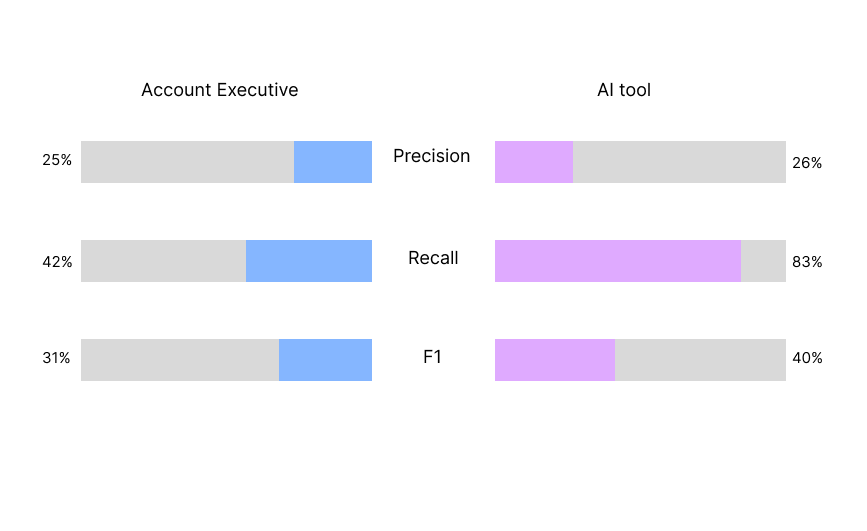
- Reduced Cycle Times: Leads scored 80+ by the AI tool showed 5-10% shorter closure cycle times, enhancing sales team efficiency.
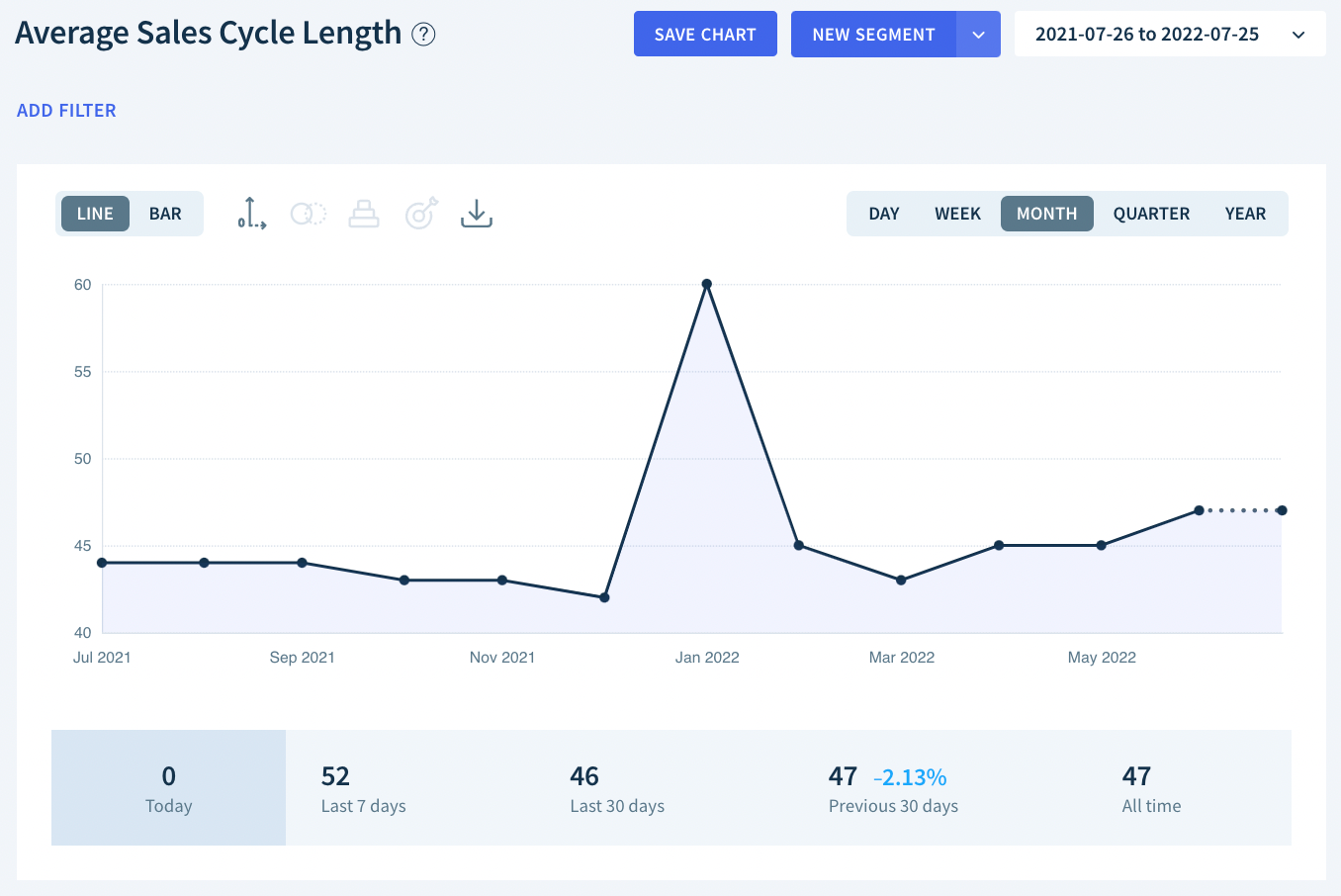
- Flexible Scoring: Unlike binary AE assessments, AI provides a nuanced 1-100 scoring scale, allowing more tailored sales approaches.
- Efficiency Gains: Sales teams reported faster BANT qualification, elimination of incomplete data issues, and more time for customer engagement and product development.
Conclusion: Workflow automation of lead scoring marked a significant leap in sales efficiency, combining human intuition with AI precision for more effective, customer-centric strategies.
Automate BANT lead qualification and scoring with our AI-driven workflows, designed by Nanonets for you and your teams.
Automated BANT Saves your Time
Let’s evaluate the potential time savings for a sales team of 50 persons, transitioning from a manual to a fully automated AI-integrated BANT workflow process. This estimation will highlight the significant efficiency gains and suggest how the saved time could be effectively utilized.
Time Savings Calculation:
- Assumptions:
- Each salesperson handles approximately 5 leads per day.
- There are 20 working days in a month.
- Manual Process Time per Lead: 22 minutes.
- AI-Integrated Workflow Time per Lead: 1 minute.
- Time Saved per Lead: 21 minutes.
- Daily Time Saved per Salesperson: 21 minutes x 5 leads = 105 minutes (1.75 hours).
- Monthly Time Saved per Salesperson: 1.75 hours x 20 days = 35 hours.
- Total Monthly Time Saved for Team: 35 hours x 50 salespersons = 1,750 hours.
Utilization of Saved Time:
The substantial amount of time saved monthly opens up numerous opportunities for the sales team to enhance productivity and engage in other valuable activities:
- Enhanced Customer Interactions: The extra time can be used for deeper engagement with potential and existing customers, building stronger relationships and understanding their needs better.
- Prospecting and Lead Generation: More time can be devoted to prospecting new clients and generating additional leads, potentially increasing the sales pipeline.
- Personalized Follow-Ups: The team can focus on creating personalized follow-up strategies for leads, increasing the chances of conversion.
- Wellness and Work-Life Balance: Importantly, this time can also be allocated for wellness activities, contributing to a healthier work-life balance by outsourcing manual tedious tasks to technology.
By leveraging the efficiency gained through workflow automation with AI, a sales team can significantly increase its productivity, enhance sales strategies, and improve overall team morale and job satisfaction.
Automate BANT lead qualification and scoring with our AI-driven workflows, designed by Nanonets for you and your teams.
Nanonets for Workflow Automation
In today’s fast-paced business environment, workflow automation stands out as a crucial innovation, offering a competitive edge to companies of all sizes. The integration of automated workflows into daily business operations is not just a trend; it’s a strategic necessity. In addition to this, the advent of LLMs has opened even more opportunities for automation of manual tasks and processes.
Welcome to Nanonets Workflow Automation, where AI-driven technology empowers you and your team to automate manual tasks and construct efficient workflows in minutes. Utilize natural language to effortlessly create and manage workflows that seamlessly integrate with all your documents, apps, and databases.
Our platform offers not only seamless app integrations for unified workflows but also the ability to build and utilize custom Large Language Models Apps for sophisticated text writing and response posting within your apps. All the while ensuring data security remains our top priority, with strict adherence to GDPR, SOC 2, and HIPAA compliance standards.
To better understand the practical applications of Nanonets workflow automation, let’s delve into some real-world examples.
- Automated Customer Support and Engagement Process
- Ticket Creation – Zendesk: The workflow is triggered when a customer submits a new support ticket in Zendesk, indicating they need assistance with a product or service.
- Ticket Update – Zendesk: After the ticket is created, an automated update is immediately logged in Zendesk to indicate that the ticket has been received and is being processed, providing the customer with a ticket number for reference.
- Information Retrieval – Nanonets Browsing: Concurrently, the Nanonets Browsing feature searches through all the knowledge base pages to find relevant information and possible solutions related to the customer’s issue.
- Customer History Access – HubSpot: Simultaneously, HubSpot is queried to retrieve the customer’s previous interaction records, purchase history, and any past tickets to provide context to the support team.
- Ticket Processing – Nanonets AI: With the relevant information and customer history at hand, Nanonets AI processes the ticket, categorizing the issue and suggesting potential solutions based on similar past cases.
- Notification – Slack: Finally, the responsible support team or individual is notified through Slack with a message containing the ticket details, customer history, and suggested solutions, prompting a swift and informed response.
- Automated Issue Resolution Process
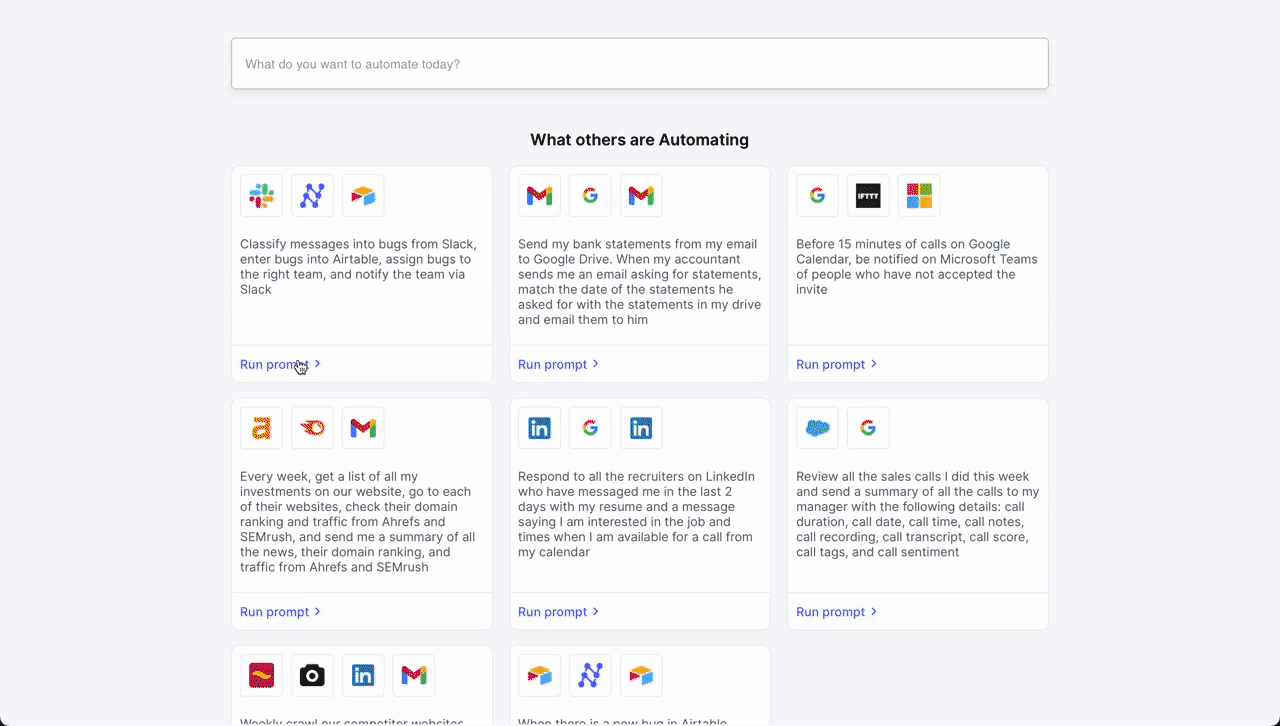
- Initial Trigger – Slack Message: The workflow begins when a customer service representative receives a new message in a dedicated channel on Slack, signaling a customer issue that needs to be addressed.
- Classification – Nanonets AI: Once the message is detected, Nanonets AI steps in to classify the message based on its content and past classification data (from Airtable records). Using LLMs, it classifies it as a bug along with determining urgency.
- Record Creation – Airtable: After classification, the workflow automatically creates a new record in Airtable, a cloud collaboration service. This record includes all relevant details from the customer’s message, such as customer ID, issue category, and urgency level.
- Team Assignment – Airtable: With the record created, the Airtable system then assigns a team to handle the issue. Based on the classification done by Nanonets AI, the system selects the most appropriate team – tech support, billing, customer success, etc. – to take over the issue.
- Notification – Slack: Finally, the assigned team is notified through Slack. An automated message is sent to the team’s channel, alerting them of the new issue, providing a direct link to the Airtable record, and prompting a timely response.
- Automated Meeting Scheduling Process
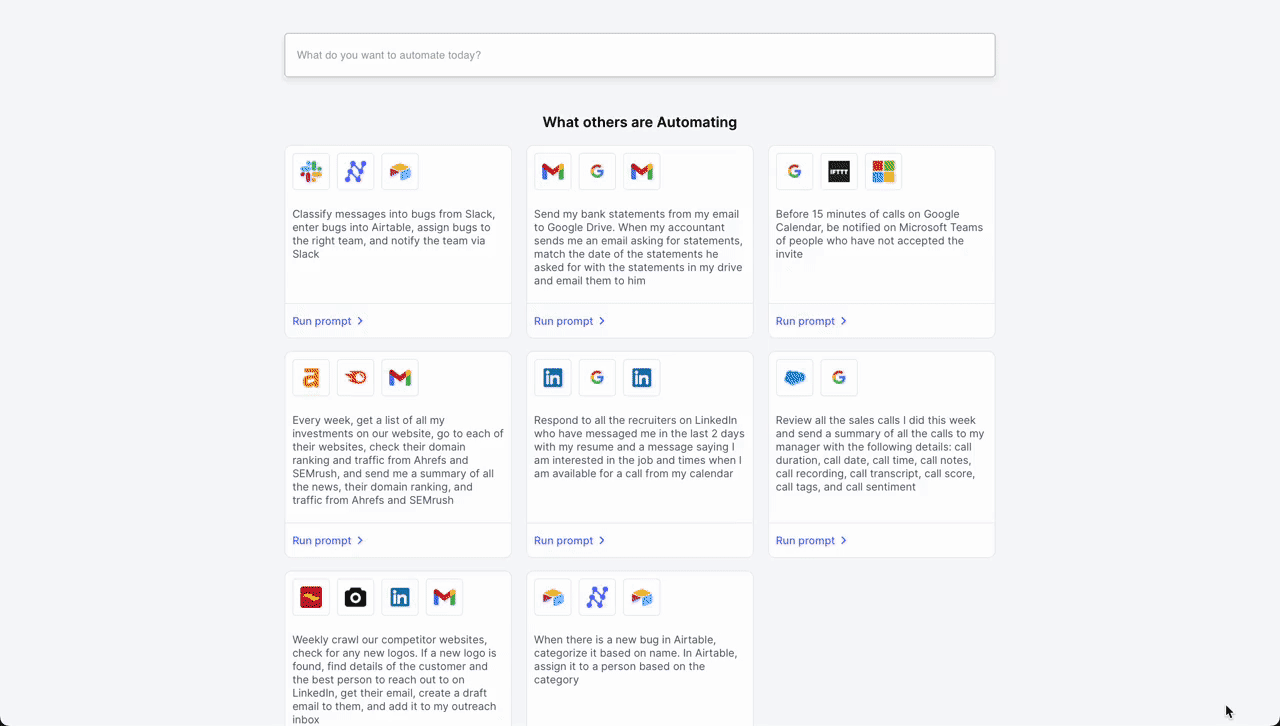
- Initial Contact – LinkedIn: The workflow is initiated when a professional connection sends a new message on LinkedIn expressing interest in scheduling a meeting. An LLM parses incoming messages and triggers the workflow if it deems the message as a request for a meeting from a potential job candidate.
- Document Retrieval – Google Drive: Following the initial contact, the workflow automation system retrieves a pre-prepared document from Google Drive that contains information about the meeting agenda, company overview, or any relevant briefing materials.
- Scheduling – Google Calendar: Next, the system interacts with Google Calendar to get available times for the meeting. It checks the calendar for open slots that align with business hours (based on the location parsed from LinkedIn profile) and previously set preferences for meetings.
- Confirmation Message as Reply – LinkedIn: Once a suitable time slot is found, the workflow automation system sends a message back through LinkedIn. This message includes the proposed time for the meeting, access to the document retrieved from Google Drive, and a request for confirmation or alternative suggestions.
- Invoice Processing in Accounts Payable
- Receipt of Invoice – Gmail: An invoice is received via email or uploaded to the system.
- Data Extraction – Nanonets OCR: The system automatically extracts relevant data (like vendor details, amounts, due dates).
- Data Verification – Quickbooks: The Nanonets workflow verifies the extracted data against purchase orders and receipts.
- Approval Routing – Slack: The invoice is routed to the appropriate manager for approval based on predefined thresholds and rules.
- Payment Processing – Brex: Once approved, the system schedules the payment according to the vendor’s terms and updates the finance records.
- Archiving – Quickbooks: The completed transaction is archived for future reference and audit trails.
- Internal Knowledge Base Assistance

- Initial Inquiry – Slack: A team member, Smith, inquires in the #chat-with-data Slack channel about customers experiencing issues with QuickBooks integration.
- Automated Data Aggregation – Nanonets Knowledge Base:
- Ticket Lookup – Zendesk: The Zendesk app in Slack automatically provides a summary of today’s tickets, indicating that there are issues with exporting invoice data to QuickBooks for some customers.
- Slack Search – Slack: Simultaneously, the Slack app notifies the channel that team members Patrick and Rachel are actively discussing the resolution of the QuickBooks export bug in another channel, with a fix scheduled to go live at 4 PM.
- Ticket Tracking – JIRA: The JIRA app updates the channel about a ticket created by Emily titled “QuickBooks export failing for QB Desktop integrations,” which helps track the status and resolution progress of the issue.
- Reference Documentation – Google Drive: The Drive app mentions the existence of a runbook for fixing bugs related to QuickBooks integrations, which can be referenced to understand the steps for troubleshooting and resolution.
- Ongoing Communication and Resolution Confirmation – Slack: As the conversation progresses, the Slack channel serves as a real-time forum for discussing updates, sharing findings from the runbook, and confirming the deployment of the bug fix. Team members use the channel to collaborate, share insights, and ask follow-up questions to ensure a comprehensive understanding of the issue and its resolution.
- Resolution Documentation and Knowledge Sharing: After the fix is implemented, team members update the internal documentation in Google Drive with new findings and any additional steps taken to resolve the issue. A summary of the incident, resolution, and any lessons learned are already shared in the Slack channel. Thus, the team’s internal knowledge base is automatically enhanced for future use.
The Future of Business Efficiency
Nanonets Workflows is a secure, multi-purpose workflow automation platform that automates your manual tasks and workflows. It offers an easy-to-use user interface, making it accessible for both individuals and organizations.
To get started, you can schedule a call with one of our AI experts, who can provide a personalized demo and trial of Nanonets Workflows tailored to your specific use case.
Once set up, you can use natural language to design and execute complex applications and workflows powered by LLMs, integrating seamlessly with your apps and data.

Supercharge your teams with Nanonets Workflows allowing them to focus on what truly matters.
Automate BANT lead qualification and scoring with our AI-driven workflows, designed by Nanonets for you and your teams.


